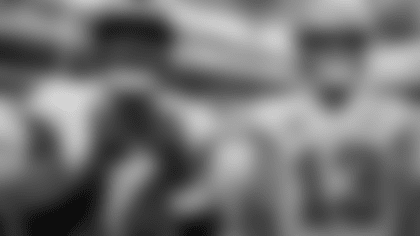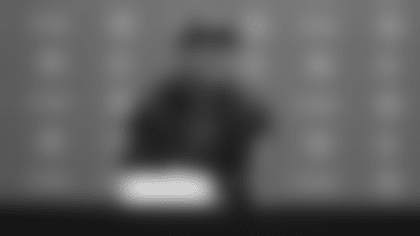The Tampa Bay Buccaneers and Green Bay Packers, long-time former NFC Central foes, each had new head coaches in 2019 and each showed clear improvement. It was a more dramatic jump for the Packers, however, as they went from 6-9-1 in Mike McCarthy's last year at the helm to 13-3 and a spot in the NFC Championship Game in Matt LaFleur's debut campaign.
The Buccaneers climbed from 5-11 to 7-9 under Bruce Arians and showed particular improvement in the season's second half, especially on defense. The team felt as it if had enough promise and roster talent to go all-in with the signing of Tom Brady, the trade for Rob Gronkowski and a cap-stretching commitment to keep its defensive front intact. Will the Buccaneers be able to make the jump to the next level? For that matter, will the Packers be able to stay at the level they reached last year? Or could these two teams meet in the middle somewhere?
The best thing the Packers did in 2019 was take care of the football and prevent its opponents from scoring. Even with two-time MVP Aaron Rodgers still playing at a high level and adjusting well to his partnership with LaFleur, and with running back Aaron Jones busting out in a big way, the Packers only ranked 18th in total offense and in the middle of the pack in both rushing and passing. The defense also ranked 18th but, more importantly, was ninth in points allowed. And Green Bay's turnover margin was tied for the third-best in the league, which certainly helped to suppress scoring.
The Buccaneers will get a close-up look at just how the Packers' offense operates on Oct. 18, when the two teams meet at Raymond James Stadium in Week Six. That will be the Buccaneers' only afternoon game in a six-week stretch from Oct. 8 to Nov. 8.
Green Bay Packers
2019 Record: 13-3
Scoring Offense: 15th (23.5 points per game)
Total Offense: 18th (345.5 yards per game)
Rushing Offense: 15th (112.2 yards per game)
Passing Offense: 17th (233.3 yards per game)
Scoring Defense: 9th (19.6 points per game)
Total Defense: 18th (352.6 yards per game)
Rushing Defense: 23rd (120.1 yards per game)
Passing Defense: 14th (232.6 yards per game)
Turnover Margin: t-3rd (+12)
The Green Bay brass chose to dedicate most of this year's draft to helping the offense, and possibly in shifting the overall focus of its attack to more of a power game. The Packers produced the catchiest storyline on the first night of the draft when they traded up four spots to select Utah State quarterback Jordan Love, probably the most polarizing QB prospect in this year's draft. It's easy to compare that move to the Packers' 2006 selection of Rodgers when they still had franchise icon Brett Favre operating at a high level, but even if history repeats itself Love shouldn't have much impact this year.
In contrast, the selections of six-foot, 247-pound running back A.J. Dillon in the second round and tight end/H-back Josiah Deguara in the third round lend credence to that idea of a philosophy shift, especially since the Packers already have the very capable Jones in the backfield. Green Bay also used the back half of the draft to load up with some depth on the offensive line. What the Packers didn't do, to the surprise of most mock drafters, was select any wide receivers in a year in which that group of prospects was considered historically deep.
Packers' 2020 Draft Class: QB Jordan Love (Round 1, 26th overall), RB A.J. Dillon (Round 2, 62nd overall), TE Josiah Deguara (Round 3, 94th overall), LB Kamal Martin (Round 5, 175th overall), G Jon Runyan (Round 6, 192nd overall), C Jake Hanson (Round 6, 208th overall), T Simon Stepaniak (Round 6, 209th overall), S Vernon Scott (Round 7, 236th overall), DE Jonathan Garvin (Round 7, 242nd overall)
Under the guidance of second-year General Manager Brian Gutekunst, the Packers were uncharacteristically active in free agency in 2019 and their forays into the market were quite successful. New edge rushers Za'Darius Smith and Preston Smith combined for 25.5 sacks, more than making up for the departure of Clay Matthews, and safety Adrian Amos had two picks and 81 tackles.
It has been a more typical Packer offseason in 2020, with only a handful of moves and most of them essentially just balancing out roster losses. Long-time right tackle stalwart Bryan Bulaga leaves and Lions cap casualty Ricky Wagner arrives. Tackle leader Blake Martinez walks in free agency and is replaced by newcomer Christian Kirksey. Wide receiver Devin Funchess takes the spot of Geronimo Allison.
Of course, the Packers' 13-3 record would suggest a roster that didn't need a massive overhaul, and the Packers shouldn't have much trouble getting past the aforementioned departures and those of outside linebacker Kyler Fackrell and tight end Jimmy Graham.
Key Veteran Additions: T Ricky Wagner (FA), LB Christian Kirksey (UFA), WR Devin Funchess (UFA)
Notable Departures: LB Blake Martinez (UFA), OLB Kyler Fackrell (UFA), T Bryan Bulaga (UFA), TE Jimmy Graham (Released), WR Geronimo Allison (UFA), FB Dan Vitale (UFA)
In addition to the Smith duo putting on a lot of pressure up front, the Packers boast a very talented secondary, including their first-round picks in 2018 (cornerback Jaire Alexander) and 2019 (safety Darnell Savage). Rounding out the starting four are Amos and a 2017 second-round steal in cornerback Kevin King. King led the team with five picks in 2019 and four other players had two as the Packers tied for third in the NFL with 17 interceptions.
Even with the nod to the future with the Love pick and the additions of Dillon and Deguara, the Packers' offense will likely only go so far as Rodgers takes it. Rodgers' yards per game were down somewhat last year but his 26-4 TD-INT ratio remained elite, and he did it with a receiving corps that didn't have an obvious number-two running mate for star Davante Adams. Adams had another 83 catches in 2019 but no other Green Bay wide receiver had more than 35. The Packers did get a sizeable contribution from the backfield duo of Jones and Jamal Williams, who combined for 2,271 yards from scrimmage and 25 touchdowns.
The NFC Central was renamed the NFC North when the Buccaneers left for the new NFC South in the league's 2002 realignment. Prior to that, the Bucs and Packers were division foes for 25 years, which is why they have already met on 54 prior occasions. Green Bay has the edge in those 54 games, 32-21-1, and also has a current three-game winning streak through games in 2011, 2014 and 2017. Favre and the Packers were the first hurdle the Buccaneers had to clear during their rise to prominence in the late '90s. Tampa Bay finally topped the Packers five times from 1998-2002, moving on to the next hurdle of Philadelphia, which they cleared in the 2002 Super Bowl season.
The lasting image from that era between the Bucs and Packers was the smiling but intense battle between Favre and the Bucs' Hall of Fame QB hunter, Warren Sapp. If the Buccaneers are to be playoff contenders again in 2020 it may be that their new era of pass-rushers, led by Shaq Barrett, will have to make the going hard for Rodgers as they try once again to prove they are at the same level as Green Bay.



































